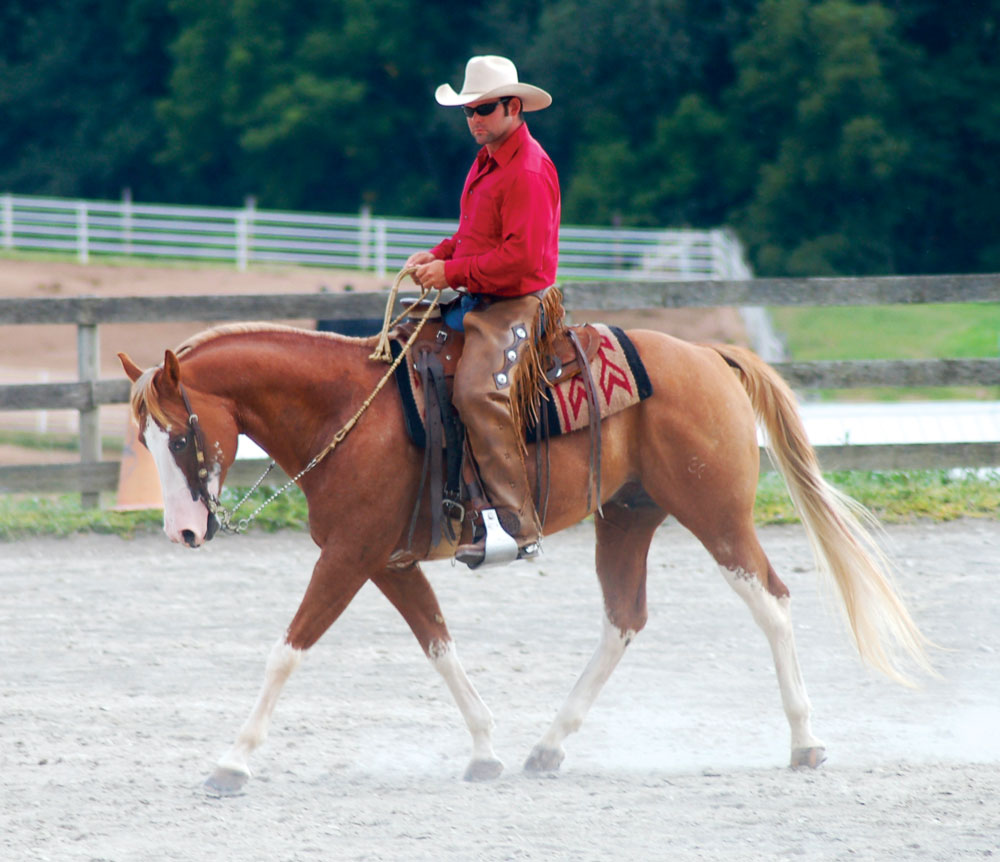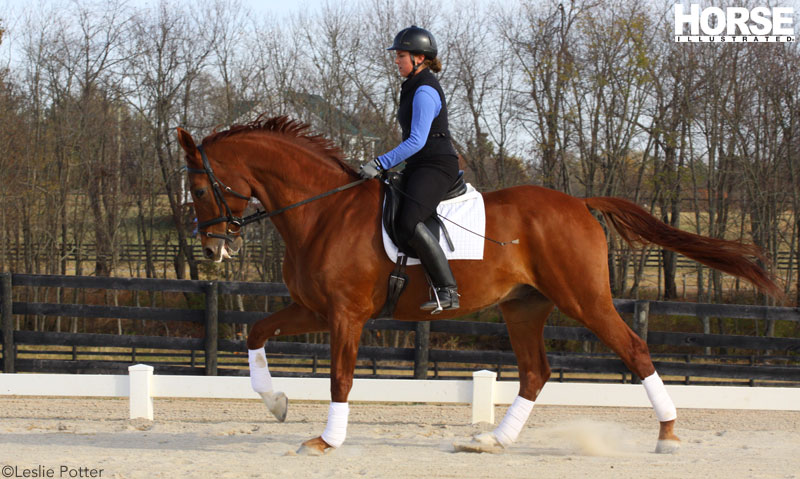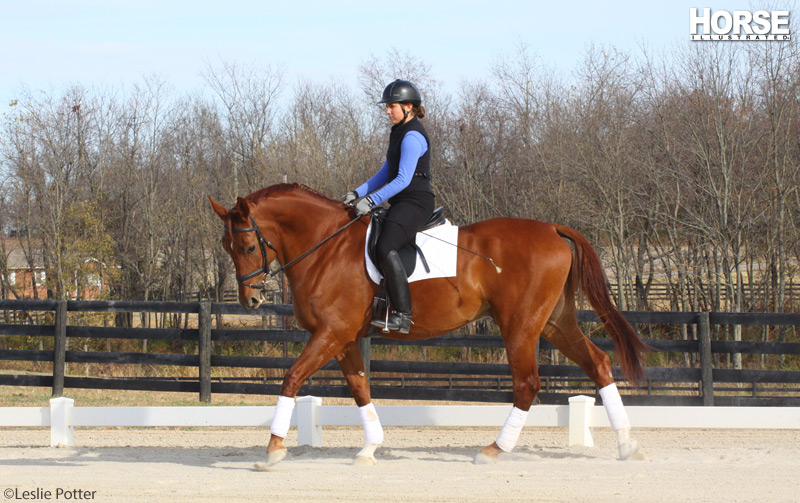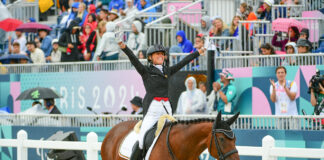
Clinician Patrick King describes his riding styles as “dressage by passion, but western by function.”
“When done correctly, transitions help with four things specifically,” says clinician Patrick King of Ashville, Ohio. “The first is helping improve the horse’s focus on the rider. The second is helping the horse better understand the seat, leg and rein aids. The third is improving the horse’s strength by properly using and building the muscles. Finally, the fourth is improving the horse’s balance by putting most of the weight on the haunches.”
Not only are transitions themselves critical in every discipline, they develop the horse as well. King tells us how to strengthen this frequently weak link.
Transition Sets
“One of my favorite ways to teach riders and horses is what I call ‘transition sets,’” says King. “For example, ride 10 strides of one gait, then make a transition to another gait for 10 strides. I’ll go typically 10 and 10 when I’m first teaching students and horses, then maybe we’ll mix it up to 10 and five, 15 and five, eight and eight, depending on what the riders and horses need.”
King’s sets can be tailored to suit horse and rider skill levels with changes between gaits, changes within the gait, and even changes within the frame. “We might start out with walk-trot and trot-canter, and then walk-canter,” he says.
“For an advanced horse, I’ll use rein-back, so we’ll do 10 strides of walk and five strides of rein back, then 10 strides of trot and five strides of rein back. Eventually we get into different working frames. For competitive dressage horses or western dressage horses in particular, we might go 10 strides of a free gait and 10 strides of a working gait, or 10 strides in a working gait and five strides in a collected gait.”

Start with 10 strides in one gait and 10 strides in the next gait. Eventually, you can work toward 10-stride sets between working and collected gait.
Lines and Figures
Whether you ride your transition sets on a circle or around the entire arena depends on the horse. “If we need to motivate a horse to have a little more impulsion, typically we’ll do more transitions on a straight line,” says King.
“If we are trying to relax the horse to help him find tempo and smoothness, we’ll do those more on circles. Straight lines and larger circles tend to help motivate the horse for forward impulsion, while smaller circles tend to balance the horse better. We’ll also spiral in and spiral out within transition sets to help the horse find the balance.”
Organize the Aids
Riding correct transitions starts with half-halts. “The half-halt is the preparation for the transition,” says King. “We need to set up the horse’s frame, posture and balance, and then the transition itself should be pretty easy. When the horse is prepared, you can simply release the horse in the transition. I always want to feel like I am releasing my horse into the next gait.”
King helps riders learn the feel of an organized transition by guiding them through the approach. “The biggest trouble I find is riders not preparing for the transition, which is actually what got me started teaching transition sets in the first place,” he says. “Often we’ll count the strides out loud; I’m very particular that the transition happens on, say, stride 10. So stride eight you prepare, stride nine you half-halt, and stride 10 you make the transition.”
Proportion of aids is the key to keeping things balanced and smooth. “We find there are some riders that use too much hand going down or too much leg going up,” says King. “In general, riding should be about 80 percent seat, 18 percent lower leg, and two percent hand, but often we find riders working 80 percent from their hand in the downward transition and 80 percent from their leg in the upward transition.”
Improve Your Horse’s Problem Gait
Transition sets work to improve the transitions themselves and also to improve the gaits. In fact, with transition sets you can use the horse’s better gait to improve his weaker gait.
“Say the horse’s jog or trot is his best gait and his canter or lope is lacking,” says King. “We might do 15 strides of the trot or jog, and then five strides of a lope or canter, so the horse has the opportunity in the better gait to get his balance and his tempo. Then when we make the transition, he’s just there for a short time before he has to rebalance and come back down to the better gait. Over time and through repetition, this helps the horse to learn to carry himself properly and wait for the rider.”
This systematic approach helps the horse move at his best. “The horse should feel like a gymnast or a dancer—like he can go forward or backward,” says King. “This has a lot to do with relaxation in the back and forward extension in the neck, reaching for the contact. This way the horse is able to lift his back, rotate his pelvis, and step deeper with his hind legs. Only when that happens can we get gymnastic benefit from our transitions.”

Ask for upward transitions during the “thrust” phase of the gait; this is the only time you can influence its quality.
Timing is Everything
Good riding boils down to clear communication with your horse. With timing that’s off, aids turn into babble. Timing refers to the moment you can properly influence the horse’s body, which is dictated by the mechanics of the horse’s movement.
Good timing requires feel, which many riders find tricky to learn. Ready for your “ah-ha” moment? Patrick King of Patrick King Horsemanship in Ashville, Ohio, breaks down this key skill into simple steps.
“I find riders often aren’t aware of what happens with the horse’s legs in the transition,” says King. “At clinics, I will often put different color boots or wraps on the legs to demonstrate what actually takes place. I then have riders call out to me the horse’s footfalls, as well as the timing of each phase of the horse’s leg.”
A horse has four phases for every step: thrust, flight, impact, and stance. King explains that you should ask for an upward transition in the thrust phase and a downward transition on impact. Those are the only moments in the stride you can influence.
When a horse is in stance, his weight is already on that foot, and when in flight, it’s already committed to a destination, so we can’t influence the leg without throwing the horse off balance, he says.
“Sometimes I’ll put a rope on a person’s foot so they can feel how their own foot can be influenced at different phases,” says King. “The biggest thing riders get is realizing how hard they’ve been making it for their horses by asking for a transition at the wrong time.” With repetition and practice, timing eventually becomes automatic.
Keeping it Smooth
Making a seamless transition takes some finesse. “It shouldn’t look like you shot the horse out of a cannon or like you just threw on the emergency brake,” says King. “We want the transition to be smooth and flawless, like if the judge were to blink, the horse would be in the next gait.”
To achieve this, King recommends riding transitions with the big picture in mind. “The first stride should look the same as the tenth stride. Say we are going from walk to canter: If the transition is ridden right, that first stride of canter should be just as balanced and through as the twentieth stride of canter.”
The key to that continuity lies in riding each gait. “Often when riding a canter-walk transition, for example, riders think about stopping the canter, when they should think about starting the walk,” says King. “You need to think about starting the new gait as opposed to stopping the other gait.”
Riding correctly before, during, and after the transition brings everything full circle. “Across all disciplines, the quality of the transition depends on the quality of the last stride of the last gait, with the quality of the first stride in the new gait the same as in the last gait,” King adds. “This in itself depends on the quality of the transition.”
Natalie DeFee Mendik is an award-winning journalist specializing in equine media. Her personal horse passions include dressage and vaulting. Visit her online at www.mendikmedia.com.
This article originally appeared in the December 2015 issue of Horse Illustrated magazine. Click here to subscribe!





